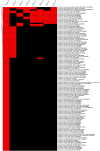Wide-genome selection of lactic acid bacteria harboring genes that promote the elimination of antinutritional factors
- PMID: 37180381
- PMCID: PMC10171302
- DOI: 10.3389/fpls.2023.1145041
Wide-genome selection of lactic acid bacteria harboring genes that promote the elimination of antinutritional factors
Abstract
Anti-nutritional factors (ANFs) substances in plant products, such as indigestible non-starchy polysaccharides (α-galactooligosaccharides, α-GOS), phytate, tannins, and alkaloids can impede the absorption of many critical nutrients and cause major physiological disorders. To enhance silage quality and its tolerance threshold for humans as well as other animals, ANFs must be reduced. This study aims to identify and compare the bacterial species/strains that are potential use for industrial fermentation and ANFs reduction. A pan-genome study of 351 bacterial genomes was performed, and binary data was processed to quantify the number of genes involved in the removal of ANFs. Among four pan-genomes analysis, all 37 tested Bacillus subtilis genomes had one phytate degradation gene, while 91 out of 150 Enterobacteriacae genomes harbor at least one genes (maximum three). Although, no gene encoding phytase detected in genomes of Lactobacillus and Pediococcus species, they have genes involving indirectly in metabolism of phytate-derivatives to produce Myo-inositol, an important compound in animal cells physiology. In contrast, genes related to production of lectin, tannase and saponin degrading enzyme did not include in genomes of B. subtilis and Pediococcus species. Our findings suggest a combination of bacterial species and/or unique strains in fermentation, for examples, two Lactobacillus strains (DSM 21115 and ATCC 14869) with B. subtilis SRCM103689, would maximize the efficiency in reducing the ANFs concentration. In conclusion, this study provides insights into bacterial genomes analysis for maximizing nutritional value in plant-based food. Further investigations of gene numbers and repertories correlated to metabolism of different ANFs will help clarifying the efficiency of time consuming and food qualities.
Keywords: LAB; lectin; phytates; saponin; tannin; α-GOS.
Copyright © 2023 Pham, Kim and Nguyen.
Conflict of interest statement
The authors declare that the research was conducted in the absence of any commercial or financial relationships that could be construed as a potential conflict of interest.
Figures




References
-
- Aderibigbe A., Cowieson A. J., Sorbara J. O., Pappenberger G., Adeola O. (2020). Growth performance and amino acid digestibility responses of broiler chickens fed diets containing purified soybean trypsin inhibitor and supplemented with a monocomponent protease. Poultry Sci. 99 (10), 5007–5017. doi: 10.1016/j.psj.2020.06.051 - DOI - PMC - PubMed
-
- Adeyemo S. M., Onilude A. A., Olugbogi D. O. (2016). Reduction of antinutritional factors of sorghum by lactic acid bacteria isolated from abacha - an African fermented staple. Front. Sci. 6 (1), 25–30. doi: 10.5923/j.fs.20160601.03 - DOI
-
- Amin H. A. S., Hanna A. G., Mohamed S. S. (2011). Comparative studies of acidic and enzymatic hydrolysis for production of soyasapogenols from soybean saponin. Biocatalysis Biotransformation 29 (6), 311–319. doi: 10.3109/10242422.2011.632479 - DOI
-
- Asare E., Yang H. M., Yang Z., Zhang H., Wang Z. Y. (2022). The role of dietary trypsin enzyme in reducing the adverse effects of trypsin inhibitors in poultry nutrition - a review. Anim. Nutr. Feed Technol. 22, 213–228. doi: 10.5958/0974-181X.2022.00018.X - DOI
LinkOut - more resources
Full Text Sources
Molecular Biology Databases
Miscellaneous

